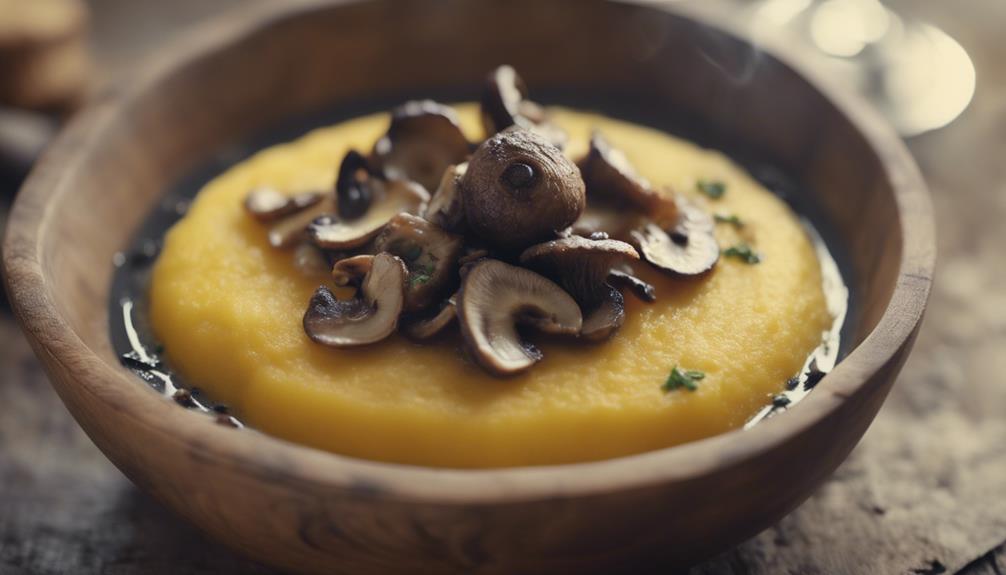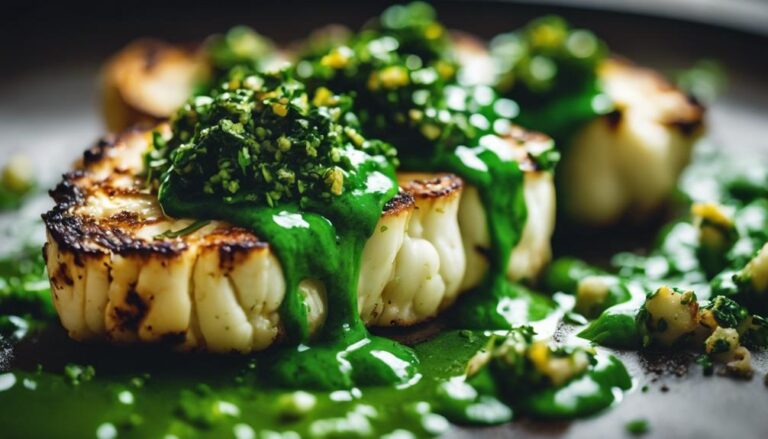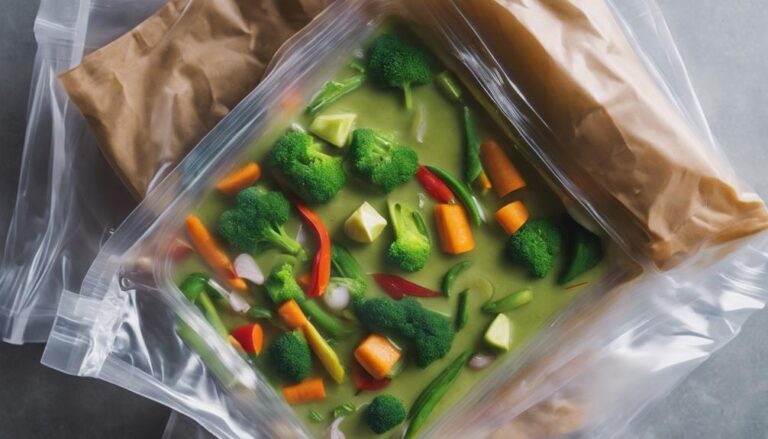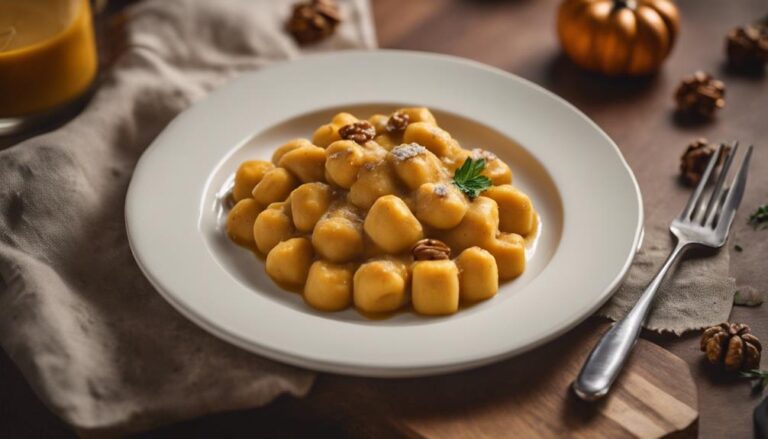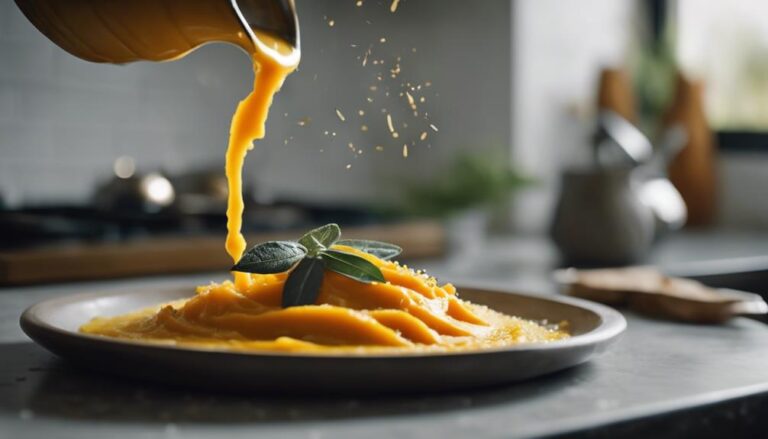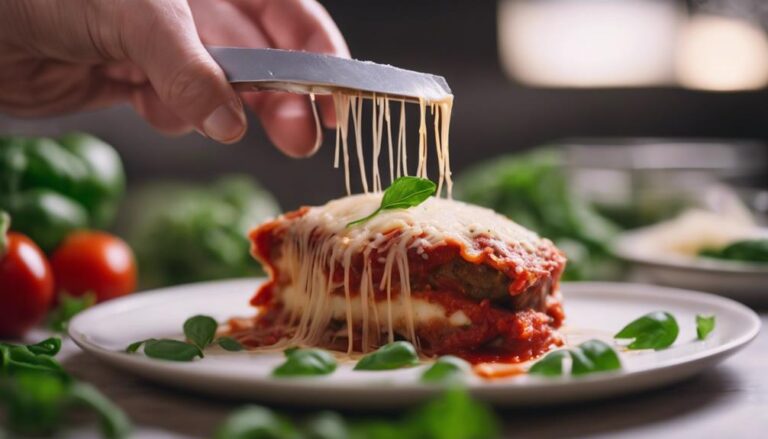Sous Vide Polenta With Wild Mushroom Ragout
Indulge in the exquisite blend of sous vide polenta and rich wild mushroom ragout. Let the flavors meld in a delightful gourmet encounter. Master the sous vide technique, ensuring a flawless blend of textures. Immerse yourself in the world of polenta with its history and versatile flour varieties. Explore the creamy base's thickness nuances for tailored perfection. The mushroom ragout, a work of art in taste, can be subtly enhanced by different varieties. Prepare for a culinary journey where the fusion of ingredients creates a symphony for your taste buds. Uncover secrets to crafting a memorable dining experience.
What You Will Learn Here
- Sous vide polenta ensures precise texture and flavor control.
- Select a variety of wild mushrooms for a diverse flavor profile.
- Infuse flavors using sous vide method for a rich mushroom ragout.
- Experiment with different mushroom combinations for complexity.
- Pair creamy polenta base with flavorful wild mushroom ragout.
Polenta's Italian Origins
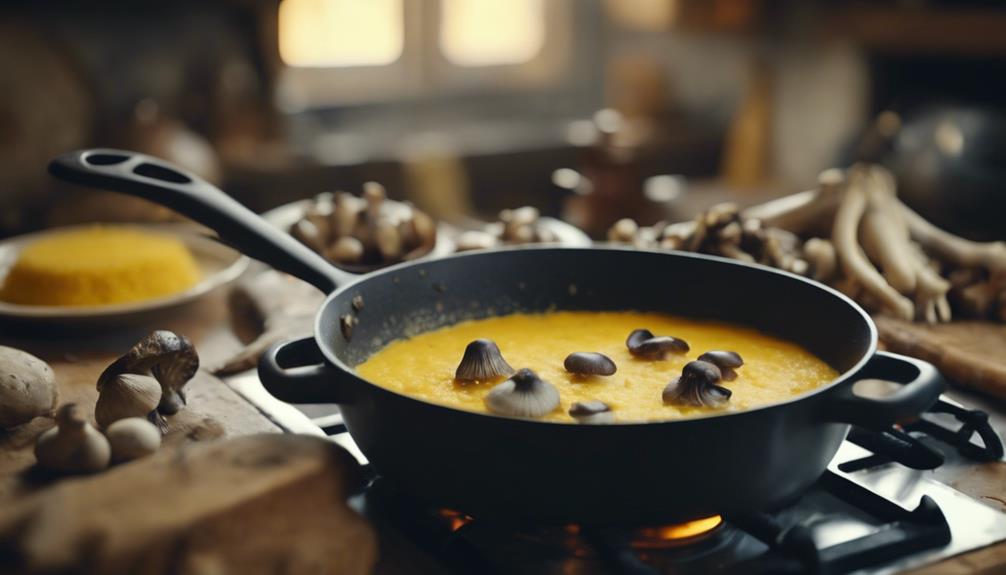
Polenta holds a significant place in Italian cuisine, tracing back to ancient times. Made from cornmeal, water, and salt, traditional polenta recipes often include variations with added cheese, butter, or herbs for flavor.
The cooking techniques for polenta vary, with some opting for stovetop simmering or baking in the oven to achieve the desired creamy or firm texture.
History of Polenta
Originally hailing from Italy, this versatile cornmeal dish known for its creamy texture has a rich history that dates back centuries. Polenta evolution, cultural significance, and its health benefits and modern variations have all played a part in shaping this beloved dish. Historically, polenta was a staple in the diets of many Italian families due to its affordability and filling nature. It was often eaten in place of bread. Today, polenta is enjoyed in various forms, from creamy to firm, and is often paired with a range of ingredients like cheese, vegetables, or meats. Below is a table illustrating the evolution and significance of polenta:
| Polenta Evolution | Cultural Significance | Health Benefits | Modern Variations |
|---|---|---|---|
| Versatile dish made from cornmeal | Integral part of Italian cuisine | Rich in fiber and nutrients | Polenta fries, grilled polenta |
Traditional Polenta Ingredients
Derived from humble origins in Northern Italy, the traditional ingredients used in crafting polenta reflect the simple yet flavorful essence of Italian cuisine. The main components consist of coarsely ground yellow or white cornmeal, water, salt, and sometimes butter or olive oil.
Cornmeal, the key ingredient, is what gives polenta its distinctive texture and slightly sweet taste. Traditional polenta recipes often call for water to be slowly poured into the boiling cornmeal while stirring constantly to prevent lumps from forming. This process allows the cornmeal to absorb the liquid and cook thoroughly, resulting in a creamy and smooth consistency.
These traditional cooking techniques have been passed down through generations, preserving the authentic flavors of this beloved Italian dish.
Polenta Cooking Techniques
Hailing from the rustic kitchens of Northern Italy, the art of preparing polenta embodies a time-honored tradition steeped in culinary finesse. When it comes to achieving that perfect creamy texture and consistent flavor, sous vide techniques have become increasingly popular.
By cooking the cornmeal in a temperature-controlled water bath for an extended period, you guarantee that every grain absorbs the liquid evenly, resulting in a velvety smooth polenta. This method also allows for easy experimentation with flavorful mushroom pairings, as the polenta's consistency remains stable and rich.
Whether you prefer a classic wild mushroom ragout or a more adventurous blend, sous vide polenta offers a versatile base that can elevate the dining experience to new heights.
Polenta Flour Varieties
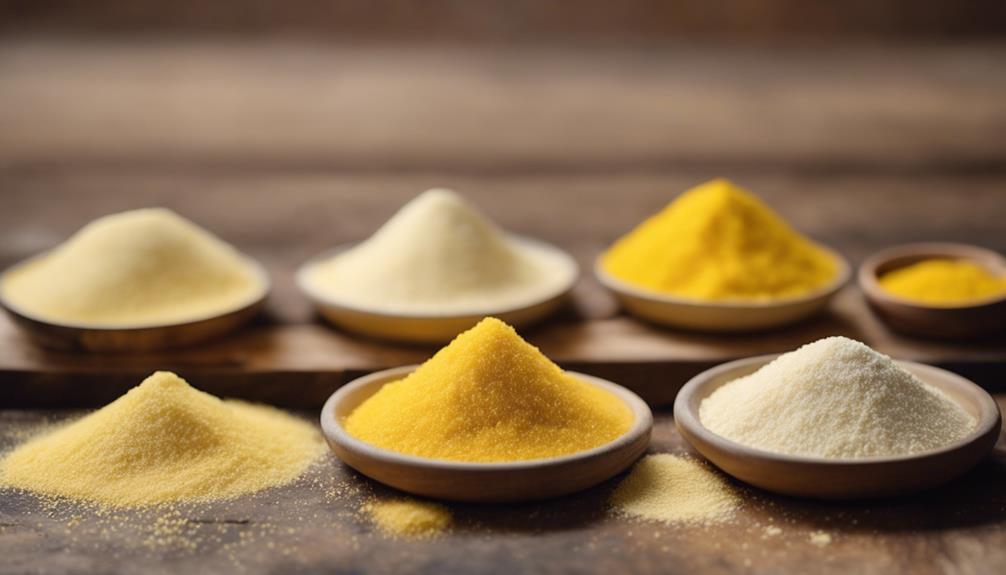
When selecting polenta flour varieties, consider the texture and flavor profile you desire for your dish. Different types of polenta flour can greatly impact the final outcome of your polenta recipes, offering a range of tastes and consistencies to suit your preferences.
Here are three common polenta flour varieties to help you choose the best one for your cooking:
- Coarse Polenta Flour: This variety, also known as traditional polenta flour, provides a more rustic texture with a slightly grainier consistency, perfect for classic polenta dishes that require a hearty bite.
- Fine Polenta Flour: If you prefer a smoother and creamier polenta, opt for fine polenta flour. This type results in a silkier texture, ideal for polenta recipes where you desire a more refined finish.
- Instant Polenta Flour: For quick and convenient cooking, instant polenta flour is a great option. It cooks much faster than traditional polenta flour varieties, making it a versatile choice for busy cooks looking to whip up polenta dishes in a jiffy.
Mouthwatering Polenta Creations
Get ready to tantalize your taste buds with a selection of irresistible polenta creations.
Indulge in a creamy mushroom polenta recipe that combines the earthy flavors of mushrooms with the rich texture of polenta.
Elevate your dining experience with a truffle-infused polenta or savor the freshness of herbed polenta paired with roasted vegetables.
Creamy Mushroom Polenta Recipe
For a delectable and indulgent dish that combines the rich flavors of mushrooms with the creamy texture of polenta, try this mouthwatering Creamy Mushroom Polenta Recipe.
- Creamy Base: Prepare a velvety polenta by slowly whisking cornmeal into simmering water until thick and creamy.
- Sautéed Mushrooms: Sauté a mix of wild mushrooms like shiitake, cremini, and oyster in butter until golden and tender.
- Assembly: Serve the creamy polenta topped with the flavorful sautéed mushrooms, garnish with fresh parsley, and a sprinkle of grated parmesan for an extra burst of flavor.
Enjoy the earthy tones of the mushrooms blending perfectly with the smoothness of the polenta, creating a dish that will leave your taste buds dancing with delight.
Truffle-Infused Polenta Recipe
Indulge in the luxurious flavors of truffle-infused polenta, elevating your culinary experience with its rich and aromatic essence. Making this exquisite dish is a delightful journey, where the earthy notes of truffle oil blend seamlessly with the creamy texture of cornmeal. Here's how to create this decadent truffle-infused polenta:
- Ingredients:
- Truffle oil for that decadent aroma.
- Cornmeal for the perfect polenta base.
- Mushrooms to add depth to the dish.
- Preparation:
- Cook the cornmeal with water until creamy.
- Stir in truffle oil for that luxurious touch.
- Top with a savory mushroom ragout for a burst of flavors.
- Enjoyment:
- Delight in the rich, velvety texture.
- Let the truffle essence dance on your taste buds.
- Pair with a glass of wine for a truly indulgent experience.
Herbed Polenta With Roasted Vegetables
Elevate your dining experience with the tantalizing blend of herbed polenta and roasted vegetables, creating a symphony of flavors in every bite. The savory herbs infuse the polenta with a rich and aromatic essence, while the roasted vegetables add a delightful crunch and sweetness to the dish.
Here's how you can enjoy this mouthwatering creation:
- Preparation: Start by cooking the polenta with a mix of your favorite savory herbs to enhance the flavors.
- Roasting: Choose a variety of seasonal vegetables like carrots, bell peppers, and zucchini, and roast them to perfection.
- Assembly: Serve the herbed polenta topped with the roasted vegetables for a dish that bursts with delicious polenta flavors and the freshness of seasonal ingredients.
Polenta Consistency Tips
To achieve a smooth polenta texture, whisk constantly while adding the cornmeal slowly to prevent clumping. Keep stirring over low heat to guarantee a creamy polenta base without any lumps.
Adjust the liquid amount gradually to reach the perfect polenta thickness that suits your taste.
Smooth Polenta Texture
For a silky smooth polenta texture, whisk the cornmeal gradually into the simmering liquid, stirring constantly to prevent lumps from forming. This method helps achieve a creamy consistency that pairs perfectly with savory flavors like wild mushroom ragout. To enhance your polenta experience, consider experimenting with different polenta variations and mushroom pairings. Check out the table below for some inspiration:
| Polenta Variations | Mushroom Pairings | Serving Suggestions |
|---|---|---|
| Creamy Parmesan Polenta | Garlic Butter Mushrooms | Top with fresh herbs |
| Cheesy Polenta | Portobello Mushrooms | Drizzle with truffle oil |
| Herb-infused Polenta | Chanterelle Mushrooms | Sprinkle with toasted pine nuts |
These combinations will take your polenta to the next level, offering a delightful culinary adventure.
Creamy Polenta Base
To achieve a creamy polenta base, whisk the cornmeal gradually into the simmering liquid, ensuring a smooth texture without any lumps. This step is vital for creating a luxurious and velvety consistency that will perfectly complement the rich flavors of the wild mushroom ragout.
The creamy texture of the polenta serves as an ideal canvas for the bold and earthy notes of the mushrooms. When preparing the polenta, consider experimenting with flavorful combinations such as adding parmesan cheese for a savory kick or incorporating a hint of truffle oil for an extra layer of depth.
These cooking tips will elevate the dish and create a harmonious mushroom pairing that will leave your taste buds delighted.
Perfect Polenta Thickness
Achieve the perfect polenta thickness by adjusting the cooking time and liquid ratios to create a creamy and decadent texture that will enhance the overall dining experience. When it comes to polenta thickness variations, everyone has their preferences. Some enjoy a thicker consistency that can be sliced, while others prefer a looser, more pourable texture. Here is a simple guide to help you achieve your desired polenta consistency:
| Cooking Time | Liquid Ratio | Resulting Consistency |
|---|---|---|
| 20 minutes | 1:4 | Thin and pourable |
| 30 minutes | 1:3 | Creamy and smooth |
| 40 minutes | 1:2 | Thick and sliceable |
| 50 minutes | 1:1 | Very thick and firm |
Final Thoughts
As we conclude our exploration of this flavorful dish, consider experimenting with different types of mushrooms for a unique twist on this sous vide polenta with wild mushroom ragout. The sous vide method offers distinct advantages, allowing for precise temperature control and flavor infusion that traditional cooking methods may not achieve. By utilizing this technique, you can guarantee that the polenta reaches the perfect consistency while absorbing the rich flavors from the wild mushroom ragout.
When it comes to the mushroom ragout pairing, focus on achieving a harmonious flavor balance. Different mushroom varieties bring their own unique taste profiles to the dish. For example, earthy shiitake mushrooms can add depth, while delicate oyster mushrooms contribute a subtle sweetness. Experimenting with a mix of mushrooms can elevate the overall complexity of the ragout, creating a more dynamic culinary experience.
Frequently Asked Questions
Can I Use Instant Polenta Instead of Traditional Polenta for This Recipe?
Yes, you can use instant polenta for a quicker cooking time, but traditional polenta often offers a more flavorful experience. Consider adding extra seasonings or cheese to enhance the taste if opting for the time-saving option.
How Can I Make This Dish Vegan-Friendly?
To make this dish vegan-friendly, substitute dairy with plant-based alternatives like almond milk for creaminess and nutritional yeast for a cheesy flavor. Amp up umami with soy sauce or miso. Choose hearty mushrooms like shiitake to enhance earthy flavors.
Can I Prepare the Polenta in Advance and Reheat It Later?
Yes, you can prepare the polenta in advance for convenience. Make ahead by cooking and freezing polenta for later use. Reheat tips include gently warming it on the stovetop with a splash of liquid to maintain its creamy texture.
What Other Types of Mushrooms Can I Use in the Wild Mushroom Ragout?
You can experiment with various mushroom varieties like shiitake, oyster, or chanterelles for your ragout. Each type offers unique flavors and textures, enhancing your dish. Try sautéing or roasting them to bring out their distinct taste profiles.
Are There Any Substitutions for the White Wine in the Ragout Recipe?
If you're out of white wine for your ragout, try using broth or stock for depth. Cooking techniques like reducing balsamic vinegar can also add a tangy complexity to your dish. Play with flavors!
Conclusion
Indulge in the velvety smoothness of sous vide polenta paired with the rich flavors of wild mushroom ragout. Elevate your culinary skills with this exquisite dish that combines traditional Italian roots with modern cooking techniques.
Follow our tips for achieving the perfect polenta consistency and treat yourself to a gourmet experience that will leave your taste buds craving for more. Bon appétit!
